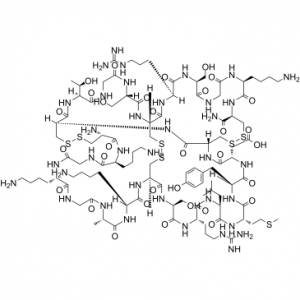Introduction from Drug peptide supply about Ziconotide/107452-89-1

| English name | Ziconotide |
| Chinese name | 齐考诺肽 |
| CAS NO | 107452-89-1 |
| Peptide sequence | Cys-Lys-Gly-Lys-Gly-Ala-Lys-Cys-Ser-Arg-Leu-Met-Tyr-Asp-Cys-Cys-Thr-Gly-Ser-Cys-Arg-Ser-Gly-Lys-Cys-NH2(Cys1&Cys16; Cys8&Cys20; Cys15&Cys25 bridge) |
| Molecular formula | C102H172N36O32S7 |
| Molecular weight | 2639.13 |
| storage temperature | 2-8℃ |
| purity | ≥98% |
| Package | 1mg;5mg;10mg;50mg;100mg,1g or according to customer’s detail requirement. |
| Product English synonyms | Ziconotide acetate; OMEGA-CGTX MVII A; OMEGA-CONOTOXIN MVIIA;snx111 |
What is ziconotide?
Ziconotide, trade name Prialt, is a 25 amino acid, three disulfide bond peptide toxoid complex extracted from the South Pacific marine snail Conusmagus. It is the first new type of neurotherapeutic drug – N-type calcium channel blocker (NCCB). It can selectively act on N-type electrosensitive calcium channels in dendrites and axon terminal branches, thereby inhibiting the initial nociceptive stimulus afferents. It is suitable for patients with severe chronic pain who need intrathecal therapy and are intolerant to other analgesic therapy (such as systemic analgesics or intrathecal injection of morphine, etc.) or have poor efficacy. Intrathecal injection of ziconotide can treat postherpetic neuralgia, phantom limb pain, HIV-related neuropathic pain, refractory cancer pain, and postoperative pain.
Chemical structure and properties of ziconotide
Ziconotide is a synthetic ω-MVIIA conotoxin, which was first discovered as a polypeptide component of hallucinogenic conotoxin. The pharmacological activity of this polypeptide relies on intact disulfide bonds, which are key determinants of molecular unit structure. The three-dimensional structure of ziconotide has been obtained by magnetic resonance method. C1-C16, C8-C20 and C15-C25 disulfide bonds make the polypeptide fold into ω knot, which has the characteristics of ω family. In addition to disulfide bonds, there are three β-sheets that further stabilize the structure. The surface of the protein is highly hydrophilic due to the connection of the charge and the polar side of the amino acid. The structure of ziconotide indicates that it may become a drug: first, the length of the amino acid sequence and its folding into an active structure provide new opportunities for artificial synthesis of clinical drugs; second, the hydrophilicity of the molecule makes it easy to form a hydrated drug form; third, the stability of ziconotide can be altered by oxidizing or reducing agents such as oxygen due to disulfide bonds and a methionine at position 12; fourth, its relative size and hydrophilicity Because of its limited tissue penetration, ziconotide can be directly transported to the region where the therapeutic molecule is located in the target cell for the most effective effect.
Pharmacological effects of ziconotide
Intrathecal injection of ziconotide can play analgesic effect in some rodent pain animal models, such as inflammatory pain and chronic neuropathic pain. At the same time, these results also fully indicate that ziconotide acts on the N-VSCC target to achieve the purpose of analgesia. The clinical mechanism of action of this product is not yet clear. The results of animal experiments show that this product binds and blocks the N-type calcium channel on the primary nociceptive afferent nerve in the superficial layer of the spinal dorsal horn, thereby preventing the excitatory nerve of the primary afferent nerve terminal. The release of transmitters against nociception. The three disulfide bonds of ziconotide form a tight rigid structure and contain four asymmetric loops. This enables it to selectively bind to NCCs with high affinity, thereby reversibly blocking the influx of calcium ions and preventing neuronal excitation and neurotransmitter release. Animal experiments confirmed that ziconotide can reversibly and dose-dependently reduce pain in experimental rat models. It may have specific effects on pain receptors. When ziconotide was directly applied to the nerve injury site in rats, it could reduce thermal hyperalgesia and mechanical allodynia, but it had no effect on normal nerves in control rats. Intrathecal injection of ziconotide into rats did not develop tolerance to the analgesic effect. Unlike morphine, intrathecal administration of an antinociceptive dose of ziconotide did not produce respiratory depression in carbon dioxide inhaled rats. Twenty-four patients with chronic pain received intrathecal ziconotide (1, 5, 7.5, or 10 μg per hour) and found neither dose- or time-related changes in respiratory rate, pulse, and blood pressure, nor physical or Changes in psychiatric assessments. In vitro experiments showed that ziconotide could effectively partially block the release of norepinephrine without affecting the release of GABA and glutamate, nor did it block neuronal nicotinic acetylcholine receptor ion channels.
How to buy Ziconotide in the U. S.
Peptide supplier remetide specializes in the production and sales of It in the USA. Professional Drug peptide R&D.Professional drug peptide seller. Welcome your purchase
Hot line:+19498788363
Wechat:americhina
Email:amin@remetide.com
